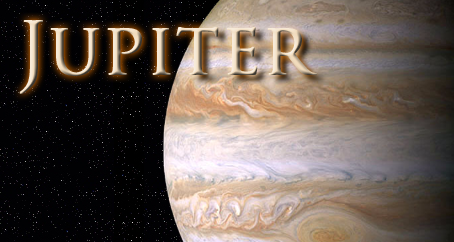Journeys to Jupiter
Jupiter is the most visited planet of the four Outer Planets or Gas Giants (Jupiter, Saturn, Uranus and Neptune). So far, eight unmanned space crafts have visited the huge planet. Pioneer 10, Pioneer 11, Voyager 1, Voyager 2, Ulysses, Cassini and New Horizons have all been flyby missions, meaning they observed Jupiter and its moons while flying past it. Galileo was an orbiter which spent several years in orbit of the planet. It also carried a probe which was dropped into the planet's atmosphere.
By the early 1970s, missions had taken place to visit Earth's nearest neighbours - the Moon, Venus and Mars - and a mission to visit Mercury was due to launch in 1973. Unsurprisingly, scientists wanted to go even further, and the next logical step was Jupiter. Whereas the Moon, Venus and Mars are all relatively close to Earth, Jupiter is much further away. And to make the journey even more of a challenge, Jupiter and the rest of the Outer Planets are separated from the Inner Planets by the Asteroid Belt, a region of thousands of asteroids. Even so, NASA mission planners, always up for a challenge, decided to give the journey a go and in 1973 were ready to send a couple of space crafts through it and on to Jupiter!
The Pioneer Mission
Pioneer 1 launched 2nd March 1972, Pioneer 2 launched 5th April 1973
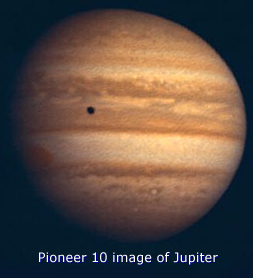
Pioneer 10 was the first space craft to complete the treacherous journey through the Asteroid Belt in July 1972 and achieved its aim of flying by Jupiter in December 1973, getting as close as 200,000 kilometres (124,000 miles) from the cloud tops of the planet. It sent back the first close-up images of Jupiter and discovered surprisingly high levels of radiation surrounding the planet. It also analysed Jupiter's atmosphere and magnetic field and took a look at some of the
planet's moons. Pioneer 10's twin probe, Pioneer 11, reached Jupiter about a year later, achieving its closest approach of 34,000 km (21,000 miles) on 3rd December 1974. From this distance, it sent back spectacular images of Jupiter's
Great Red Spot. After passing Jupiter, Pioneer 10 continued on its journey heading out of the Solar System. Despite not visiting anything else, it sent back regular data about outer space until 31st March 1997. Contact was made occasionally afterwards, mainly
as training exercises for NASA staff, until contact was lost on 23rd January 2003.
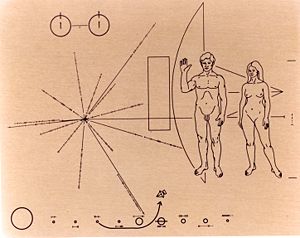
Pioneer 10 still continues its journey, although no longer sends back any information about its adventure. It is heading in the direction of a star called Aldebaran, a red giant star in the Taurus constellation. It should get there in about 2 million years, and just in case anybody/thing happens to be in that region at that time, there is a plaque (pictured below) onboard Pioneer 10 with a diagram of a man and a woman and some other, apparently meaningful, doodles for them to have a look at. Seeing as the diagram doesn't make much sense to human beings without having it explained, who knows what extra-terrestrial beings would make of it? Pioneer 11 also had an identical plaque onboard and would also end up going on a journey out of the Solar System but not before taking in the sights of Saturn. Pioneer 11 would use a method called gravity assist to get it from Jupiter to Saturn. With this method, the space craft would use the gravity of one planet to pick up speed (since the planet travels at a greater velocity than the space craft). As it passes by the planet while attracted by its gravity, it can be boosted out of this orbit and onto a different trajectory, therefore getting to another destination quicker and by using less fuel. The method had already been tried with Mariner 10 earlier in 1974 which used the gravity of Venus to get it to Mercury, and Pioneer's use of Jupiter's gravity to get it to Saturn paved the way for a similar technique to be used for later missions, most notably Voyager.
The Voyager Mission
Voyager 1 launched 5th September 1977, Voyager 2 launched 20th August 1977
Originally planned as a "Grand Tour" of the Outer Planets, Voyager was officially a two-probe mission to visit just Jupiter and Saturn with the possibility of mission extensions to go on to visit Uranus and Neptune, using the gravity assist method of Pioneer 11 to get from one planet to the next. Although Voyager 1 was launched 16 days after Voyager 2, it actually reached Jupiter four months before Voyager 2 in January 1979 (maybe it knew a shortcut through the Asteroid Belt!). Achieving its closest approach on 5th March 1979 (349,000 km or 217,000 miles), Voyager 1 sent back amazing images and other scientific data from Jupiter, completing its flyby by April before going off on its way to Saturn. Shortly after Voyager 1 left Jupiter, Voyager 2 turned up to take some more pictures and do some more analysing. Although Voyager 2's main receiver broke down ten months into its journey, communications were maintained through its back-up receiver, and still are to this day! Voyager 2's closest approach to Jupiter was on 9th July 1979 and like Voyager 1, it was sent onwards to Saturn after completing its flyby of Jupiter by August 1979.
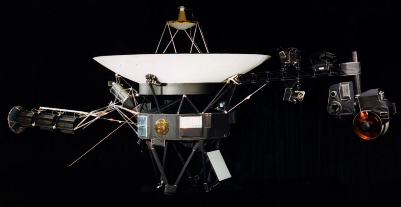
Between the two Voyager probes, three new moons of Jupiter were discovered (Metis, Adrastea and Thebe) as well as Jupiter's rings which proved that Saturn isn't the only planet with rings. In fact, Voyager 2 would later discover that rings orbit all of the Gas Giants. Analysis of Jupiter's largest moons revealed them to be very interesting bodies, much more exciting than the one orbiting Earth! Nine volcanic eruptions were observed on Io, making it the first place other than Earth where current volcanic activity has been witnessed. Analysis of Europa suggests that the moon is possibly covered with a surface of ice, probably 30 kilometres (18 miles) thick floating on a deep ocean of water, preventing from freezing by the heat generated by the moon's active core.
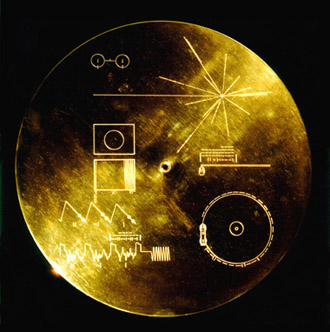
Today, about 30 years after their encounter with Jupiter, the two Voyager probes are still active. After visiting Saturn, Voyager 1 was sent on its journey out of the Solar System, and is now the most distant man-made object in space somewhere at the edge of the Solar System and looking for the exit. Voyager 2 benefited from a mission extension which took it to Uranus and then Neptune before also being sent out of the Solar System. Like Pioneers 10 and 11, they were sent bearing gifts for any passing aliens/lost astronauts/space craft collectors. Taking advantage of state-of-the-art 1970s technology, the Voyager crafts carry gold-plated records! Covering the record is another plaque of confusing drawings. The records themselves contain images, sounds and music from Earth, and even comes with a rather handy portable record player!
More information about the Voyager Mission is available here
The Galileo Mission
Galileo launched 18th October 1989
Named after the Italian astronomer who discovered Jupiter's largest moons (Io, Europa, Ganymede and Callisto), Galileo was launched in 1989 (the space craft, not the astronomer!) on a mission dedicated to the exploration of Jupiter and its moons. Galileo used gravity assist to gain speed and save fuel, using the gravity of Earth and Venus to do so and took almost six years to reach its destination. Whereas previous and future missions simply flew by Jupiter, Galileo actually went into orbit of the planet and spent several years there. On its approach to Jupiter, Galileo witnessed Comet Shoemaker-Levy's spectacular collision into Jupiter in July 1994. It sent back images of the collision (such as the one below) and the scars that remained visible in the planet's atmosphere for the months following. This was the first time that a collision of two space objects had been observed.

As Galileo got closer to Jupiter, it released a probe in July 1995 which would plunge into the planet's atmosphere later that year. Galileo itself entered into an orbit of Jupiter on 8th December 1995, a day after the probe released in July began its descent through Jupiter's atmosphere. As the probe dropped through Jupiter's virtually endless sky, it sent back information about the planet's temperature, wind speed, atmospheric conditions and pressure. It communicated for almost an hour but by the time it was being subjected to pressures 22 times greater than surface pressure on Earth and at temperatures of 153°C (307°F), it is likely to have been crushed before melting and vapourising. Not a pleasant way to go! While the Galileo probe was experiencing its violent end, the Galileo orbiter was quite peacefully orbiting the planet and taking in the scenery. As well as snapping photos of Jupiter and sending back scientific data, it had a look at Jupiter's rings, discovering that they are formed from dust particles being kicked up as meteoroids impact the four innermost moons (Metis, Adrastea, Amalthea and Thebe). It also discovered that Jupiter's outer ring is actually two rings embedded together. Mission extensions allowed Galileo to pay Jupiter's moons some more attention. It confirmed more volcanic activity on Io, discovering it to be 100 times more volcanically active than Earth. It confirmed that Europa's surface is water ice and below it is likely to be an ocean of salt water. It also suggested that Callisto and Ganymede may also have a layer of saltwater. It also discovered that Ganymede has a magnetic field, the only moon known to possess one, due to having an iron core. After completing its mission, the Galileo orbiter met the same fate as its descent probe when it was sent plunging into the planet's atmosphere to be destroyed on 21st September 2003. This was to prevent it from colliding with Europa and causing possible contamination of the moon's water. During its time at Jupiter, Galileo completed 35 orbits of the planet and several flybys of each of Jupiter's known moons.
Ulysses
Ulysses launched 6th October 1990
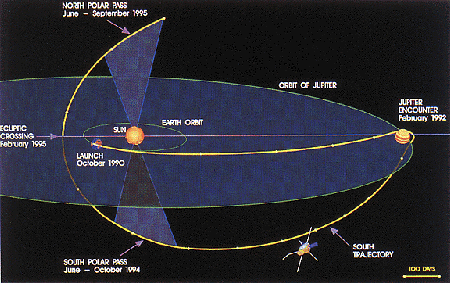
Ulysses is a mission to explore the Sun while in a polar orbit of the star. This means that instead of orbiting the Sun around its equator on a similar plane to the orbits of Earth and the other planets, the probe goes around the top and bottom of the Sun. In fact, if you want to sound clever, it orbits on a plane with an 80.2 degree inclination of the ecliptic. However, getting a space craft into an Out-of-the-Ecliptic (OOE) orbit around the Sun would require one huge rocket and lots of fuel. Alternatively, it could use the tried and tested gravity assist method. In the case of Ulysses, the space craft was launched from the Space Shuttle Discovery and sent to Jupiter. It was originally going to launch on 1986 from Space Shuttle Challenger, but due to the Challenger disaster in January of that year, the Ulysses mission was delayed. When it reached Jupiter, it used the planet's gravity to propel the craft onto a different plane. This enables the craft to travel around the Sun at a distance ranging from the distance of the orbit of Jupiter (its aphelion) to the distance of the orbit of Earth (its perihelion). While at Jupiter in February 1992, it took the opportunity to do a spot of analysis, measuring the planet's magnetic and radiation fields. As the craft isn't equipped with cameras, it didn't take any pictures. In 2004, the craft made further analysis of Jupiter at a distance of 240 million kilometres from the planet. Ulysses ended its mission in June 2009.
Cassini-Huygens
Cassini-Huygens launched 15th October 1997
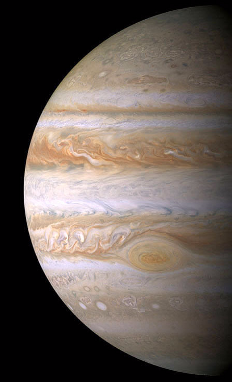
Cassini-Huygens is a mission to explore Saturn, but like previous visitors, it used gravity assist to get there. Rather cleverly, it used the gravity of Earth, Venus and Jupiter to get the craft to Saturn in an effort to reduce costs and increase speed, or perhaps just to show off. After completing two gravity assisted flybys of Venus in 1998 and 1999 and then a gravity assisted flyby of Earth, Cassini-Huygens went on its way to Jupiter. While flying by Jupiter from December 2000, it sent back over 26,000 images of the planet, providing the most detailed pictures of Jupiter to date. It also provided new information about Jupiter's atmospheric conditions. The craft is now in an active orbit around Saturn.
New Horizons
New Horizons launched 19th January 2006
New Horizons is a space craft on its way to visit Pluto and the Kuiper Belt to complete the first mission in this region of space. Once again to get there, it used the gravity assist method and, unsurprisingly, Jupiter was the planet chosen to lend its gravity to the mission. In the case of New Horizons, Jupiter was used to increase the speed of the craft (which was already travelling at record speeds) and sent it onto a different orbital plane to the rest of the planets seeing as Pluto, being a bit odd, also orbits on a different elliptical plane. The craft began imaging Jupiter in September 2006 and completed its flyby of the planet between January and May 2007, only a year after launch. While at Jupiter, it did the usual scientific things, paying particular attention to its four largest moons. New Horizons was also the first craft to analyse Jupiter's newly formed Little Red Spot, or Oval BA to give it its official name (a spot with a qualification?). It is now still en route to Pluto and should get there in 2015.
Future Missions
In 2011, NASA launched Juno, a spacecraft which will explore Jupiter while in orbit of its poles. As well as analysing Jupiter's magnetic and gravitational fields from polar orbit, it will also try to uncover information about the formation of the planet and attempt to discover whether the planet has a rocky centre and how much water is present in its atmosphere. A possible future spacecraft is Europe's Laplace probe. Currently in its proposal stages, and expected to be launched in collaboration with NASA and the Japanese Aerospace Exploration Agency if approved, Laplace will go into orbit of Jupiter and analyse it and its moons with particular attention being paid to Europa, investigating the possibility of the moon being able to harbour life. In addition to these missions, missions to other destinations in the Solar System may rely on Jupiter's gravity to get them there. And more than likely during these missions, Jupiter will again be observed during the flybys.
